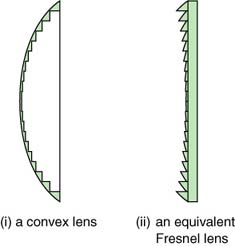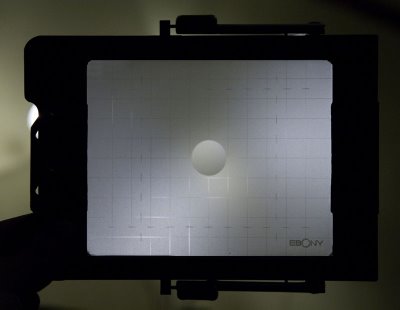Maxwell Screens Replacement Fresnel

I received my Maxwell replacement fresnel today and wanted to post a couple of comments on what I thought of it. Firstly, it may help to know what a fresnel is. The image above should help a little with this.
A fresnel is a normal lens but cut into lots of donut shapes and squished flat. A well designed fresnel should behave almost exactly the same as the equivalent lens. So what is a fresnel used for .. Well the main use is in helping view wide angle lenses where if you only have a ground screen you will tend to get a ‘hot spot’ in the centre and dark corners. A fresnel can focus the light back into your eye as shown below.
The standard fresnel with the Ebony is satisfactory but I got spoilt by seeing the Maxwell screen that Joe Cornish is using which has the added advantage of having no markings on it whatsoever (although I might need to add tilt markings for the assymetric tilt). The Ebony fresnel also has a distinct central circle where there is no fresnel cuts which shows as an obvious mark on the screen. The image below shows real photograph of both fresnels.
I’m extremely happy with the Maxwell screen which, although it costs nearly £200, enhances every lens I own. The big surprise is what a difference it makes to the 80mm Schneider Super Symmar XL. I had to check that I hadn’t put the 110 on by mistake it’s that even and bright. I also checked it with the 360 and 500 to see if I would get dark corners (with longer lenses the fresnel can ‘over focus’ which means you end up with a hot spot but for a different reason – this can look really peculiar) but there was no problem at all. The only lens that was slightly worse for field of view was the 240 but not in any significant way (and I think this may be just me being picky).
I have a feeling that the difference between the two fresnels is that the Ebony is probably made to a lesser precision and hence suffers from blurring and abberations. With the Maxwell screen, the lines that are prominent on the Ebony are very thin and the image between the faint lines is a lot crisper. This makes focussing lenses easier, and in the case of the 80SSXL, a LOT easier. I suppose it’s only like any other lens construction, the better made – the better the image.
The big test is how it affects my composition. I’m hoping that the lack of lines in the frame will let me concentrate on the composition as a whole and that the even-nes of illumination will also let me see the whole picture at once in a much clearer way.



6 Responses to “Maxwell Screens Replacement Fresnel”